The Great Outdoors: Weather Safety
Are you Weather-Ready for the Great Outdoors?
Lightning
Flash Flooding
Heat
Air Quality
Extreme Cold & Winter Storms
Ice Safety & Avalanche Danger
Know Before You Go!
The Great Outdoors are wondrous, awe inspiring, and both physically and mentally beneficial to experience. However, the Great Outdoors bring with them various weather and environmental hazards that can ruin your adventure and even be very dangerous. It is important to know your risks, take action to prepare and minimize those risks, and serve as an example for others to emulate. Here are some fundamental actions you can take and safety content you can share with family, friends, and across social media.
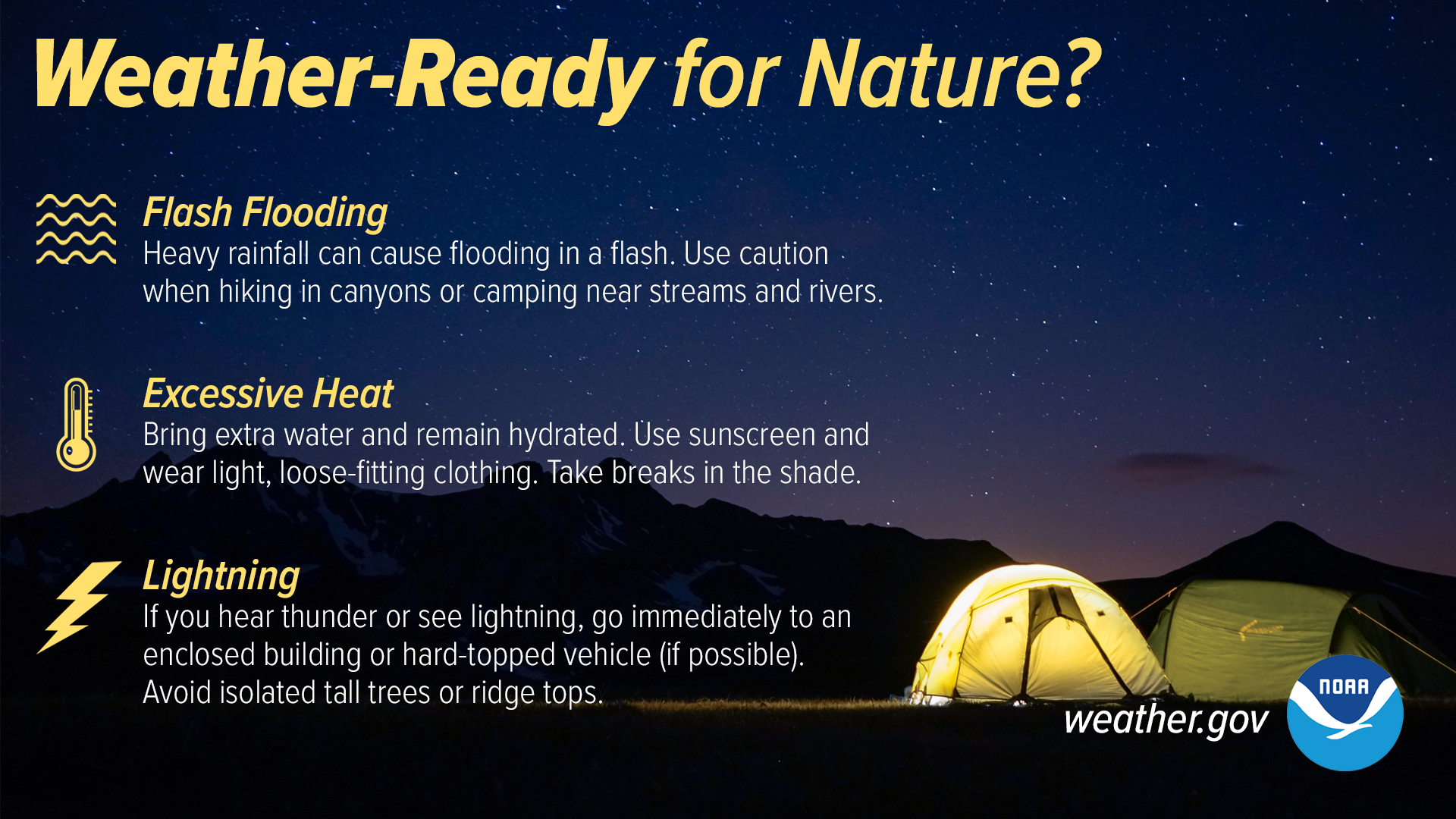
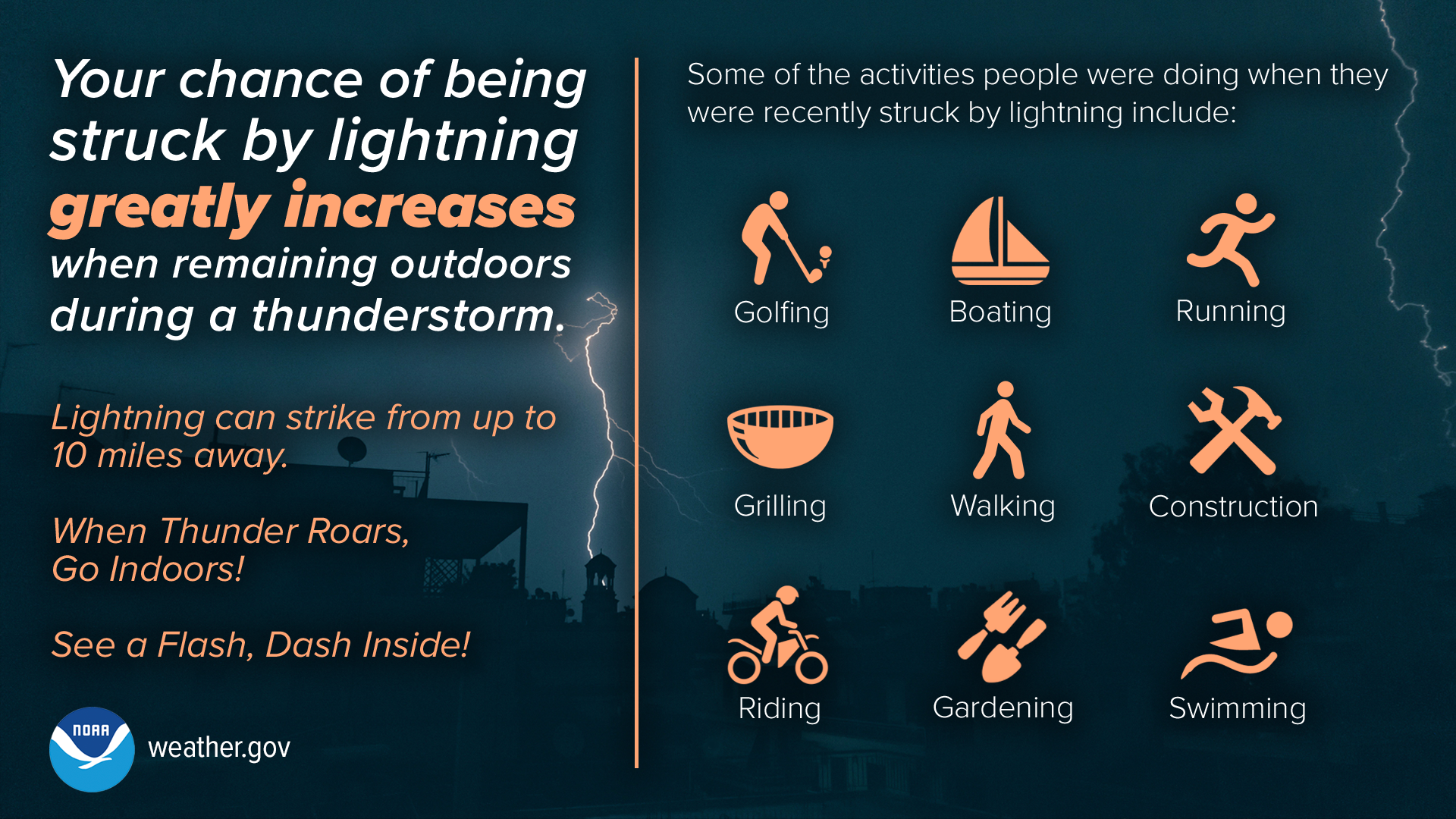
The Great Outdoors, especially during the warmer months, can be susceptible to quick forming thunderstorms. The weather can change dramatically in mountainous areas and near large bodies of water. Extreme weather can be a bit more extreme in the Great Outdoors. Make sure you plan ahead and “know before you go” to the chances of lightning in the forecast.
Some quick tips include:
- Schedule day hikes or other activities to avoid times when thunderstorms are possible (which typically form in the late afternoon).
- Identify locations with adequate shelter and reduced exposure to lightning.
- Keep a close watch of the sky and look for those towering clouds bubbling upward. These can be thunderstorms forming.
Are you planning to camp or hike near a stream or river? Remember that it doesn’t have to rain directly over you for there to be flooding. If you notice even a slight rise in water level, seek higher ground immediately!
Slot canyon flash flooding
Slot canyons are nature’s masterpieces, but are also susceptible to flash flooding. Flooding can occur even if there is blue sky above as rainwater can flow from an area that flows into the slot canyon.
Know the signs of an impending flash flood:
- Rising water levels and/or stronger currents
- Increasing roar of water up canyon
- Floating debris
- Sudden changes in water from clear to muddy
Videos:
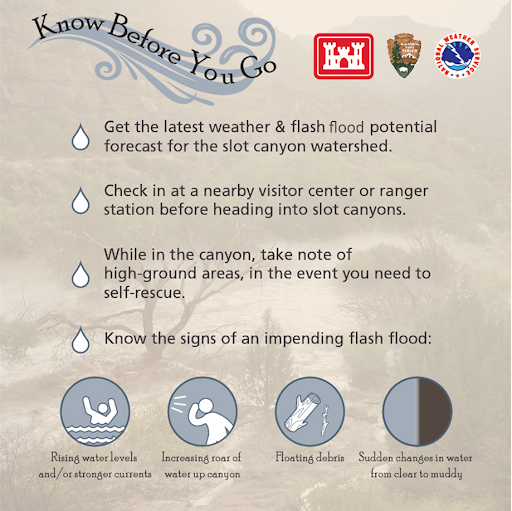
During hot and humid weather, your body's ability to cool itself is challenged in ways you may not expect. When your body heats too rapidly, or when too much fluid or salt is lost through dehydration or sweating, you could experience a heat-related illness.
Stay safe outdoors during the heat:
- Slow down. Reduce, eliminate or reschedule strenuous activities until the coolest time of the day.
- Drink plenty of water (not very cold), non-alcoholic and decaffeinated fluids, even if you don't feel thirsty.
- Dress for summer. Wear lightweight, loose fitting, light-colored clothing to reflect heat and sunlight.
- Minimize direct exposure to the sun. Sunburn reduces your body's ability to dissipate heat.
- Eat light, cool, easy-to-digest foods such as fruit or salads. If you pack food, put it in a cooler or carry an ice pack. Don't leave it sitting in the sun. Meats and dairy products can spoil quickly in hot weather.

Everyone is at risk to the dangers of heat illness, but some people are especially vulnerable:
- Newborns / children
- Pregnant people
- The elderly
- People with chronic illness
Age and certain conditions make the body less able to regulate temperature. Take extra care to ensure they remain safe from the heat.
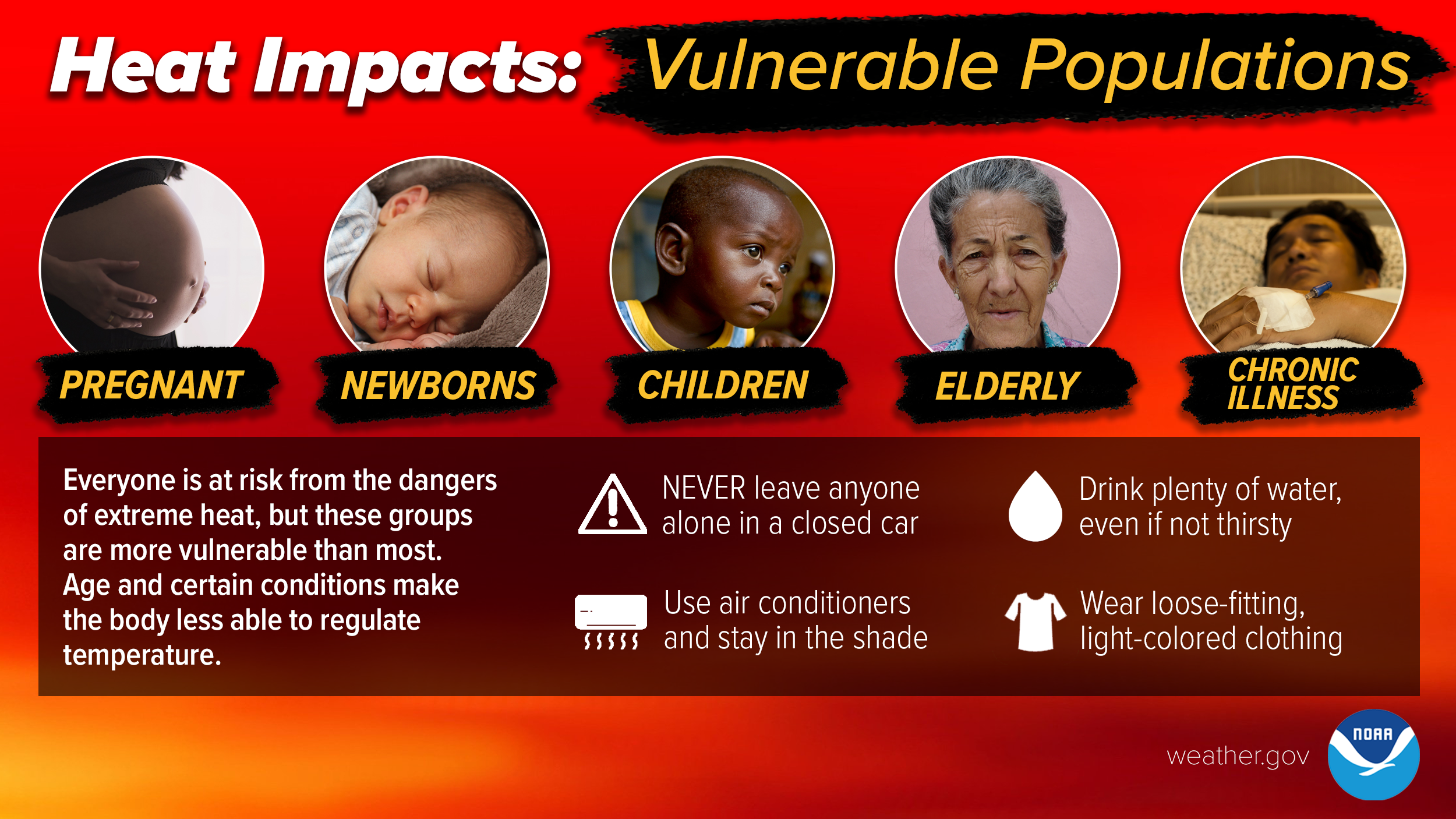
Before you go out, check the check the air quality forecast.
Poor air quality can be hazardous to anyone, and it can aggravate health problems such as asthma, heart disease, and lung disease. Seniors, children and those with compromised immune systems are especially at risk.
Air quality is reported using the Air Quality Index (AQI). It tells you how clean or polluted your air is, and what associated health effects might be a concern for you. The higher the number, the greater the health concern. Learn more about the AQI at airnow.gov/aqi/aqi-basics
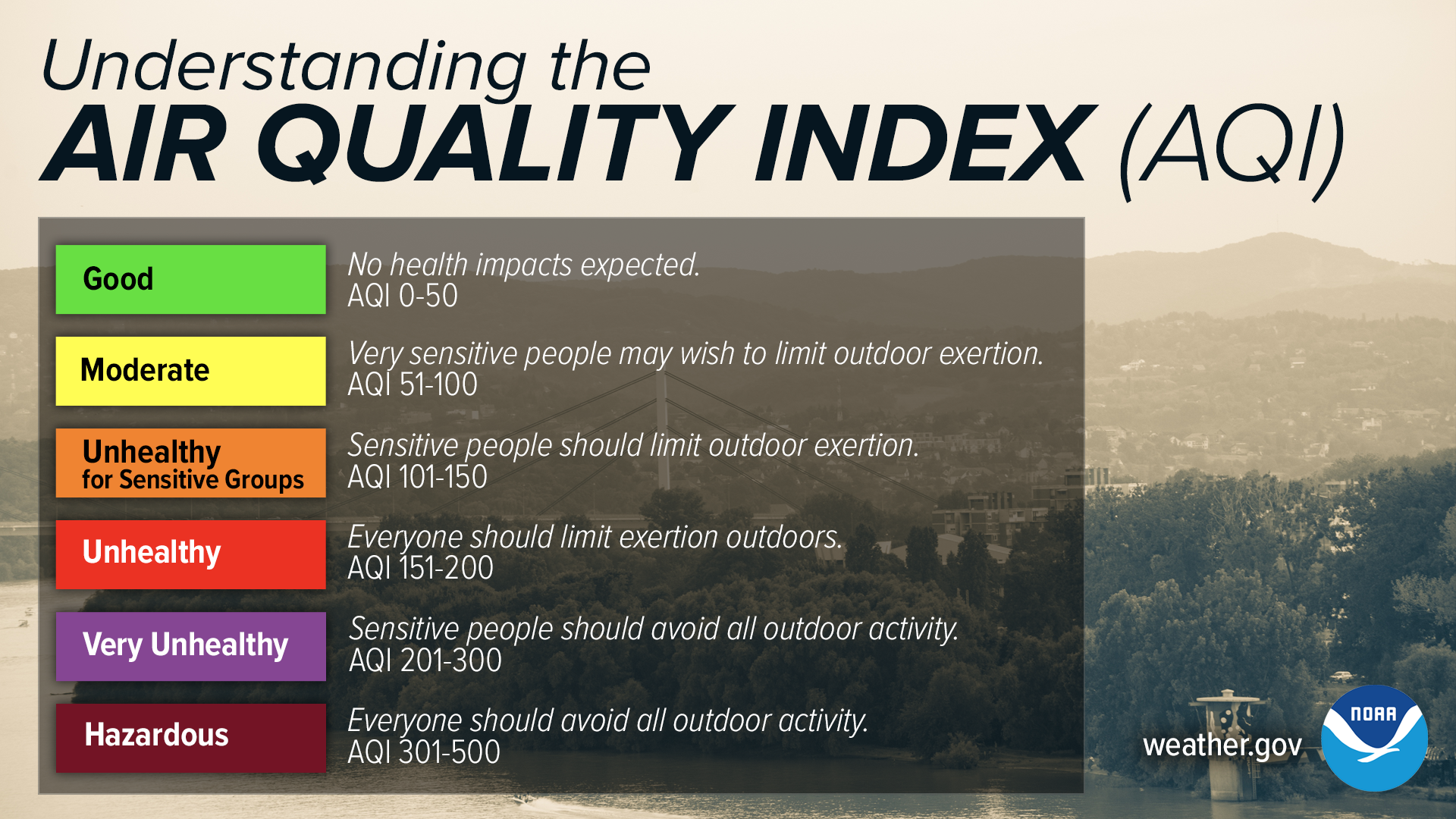
When planning a winter outing, stay safe! Check the forecast ahead of time, pack necessary gear, and dress appropriately for expected conditions. Winter conditions can change rapidly, and failure to adequately plan can be life-threatening. Weather.gov should be visited early and often.
Outdoor winter adventures expose individuals to multiple safety hazards, and extreme cold tops the list. Extreme cold magnifies the risk of cold-related illnesses, including frostbite and hypothermia, a serious condition involving a drop in body temperature and requiring immediate medical attention (It’s important to understand, however, that prolonged exposure to any environment colder than your body temperature can lead to hypothermia. This includes immersion into cold water even when the air temperature is warm).
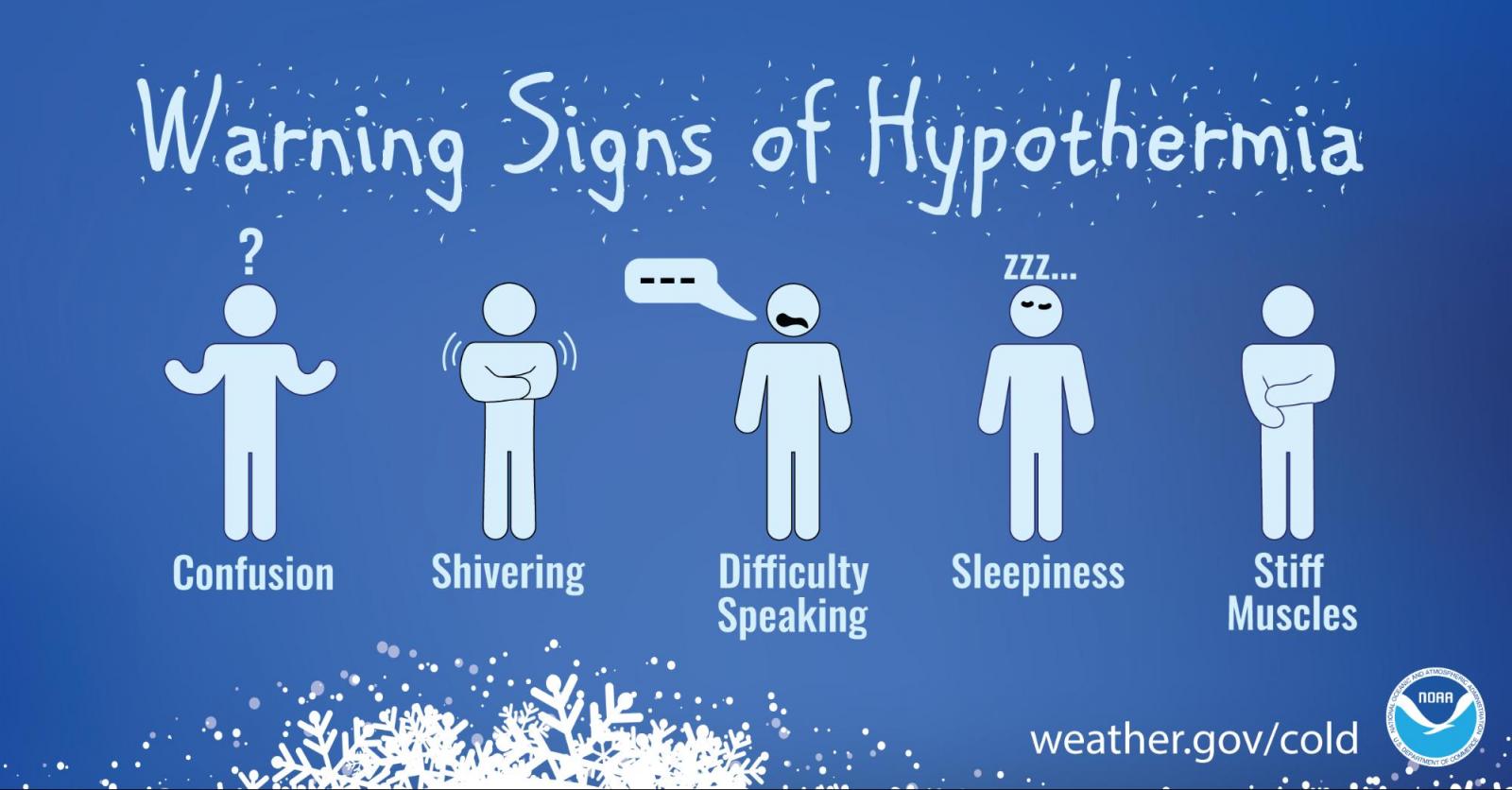
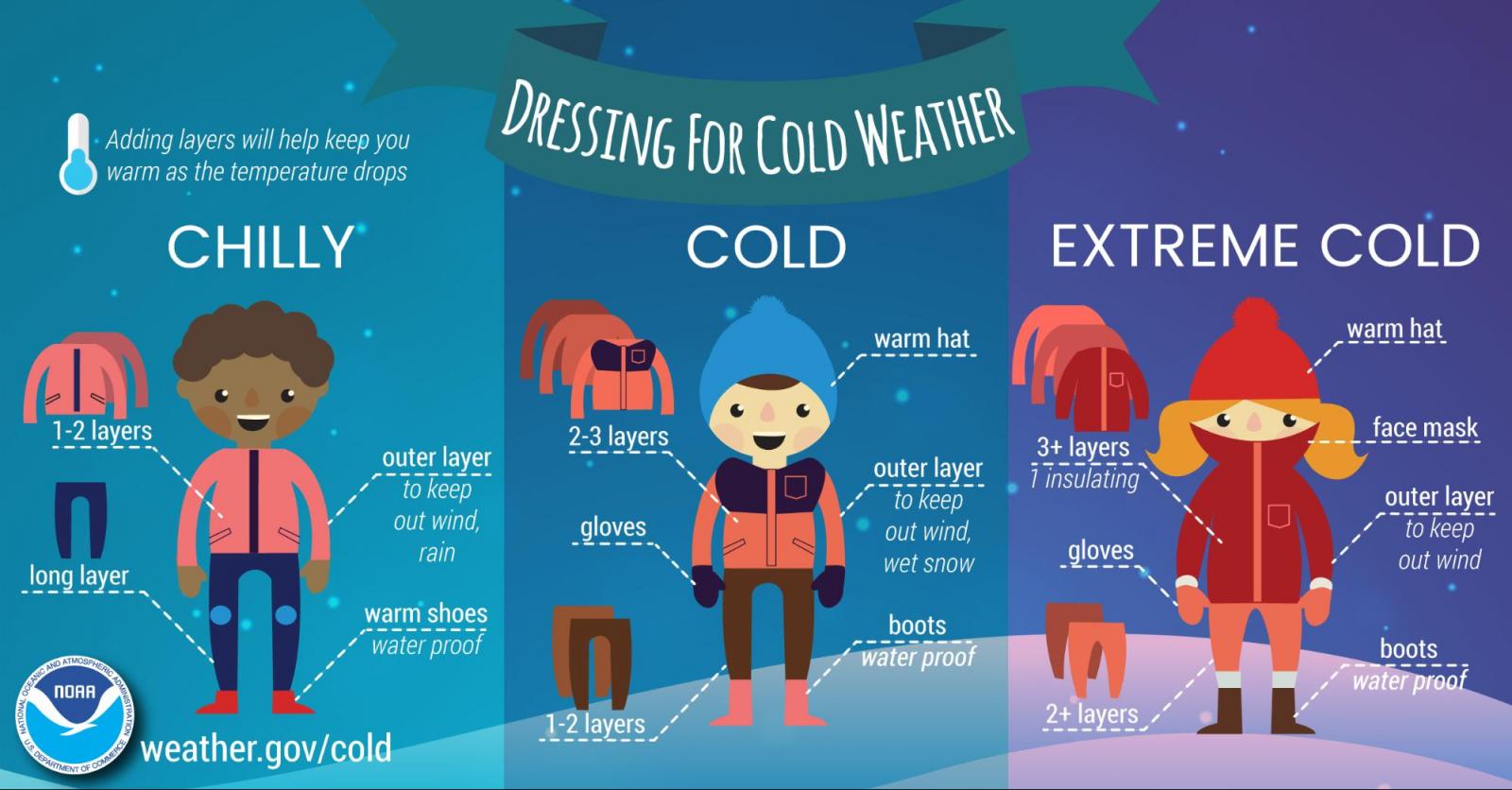
Dressing in layers prevents your body from becoming too warm or cold by creating layers of insulating air. A moisture-wicking material as your first layer will prevent clothing from trapping moisture/sweat against your skin, and a waterproof but breathable outer layer is highly recommended. Waterproof boots are a great choice for footwear since wet feet lose heat 25 times faster than dry feet. Gloves, ear muffs, and head coverings should also be worn, as frostbite can begin on exposed skin just minutes after exposure to bitterly cold wind chills.
Do Not Venture Out Alone
Winter landscapes can be decorated in layers of snow and ice, but the snowy surroundings can quickly become disorienting, causing you to lose your sense of direction. Hiking with a companion decreases the risk of getting lost, and if an accident happens, having a safety partner improves your chances of returning safely.
If you head out alone, always inform someone of where you are going and what time you will return. Stock essential items in your car and backpack in case of an emergency.
References:
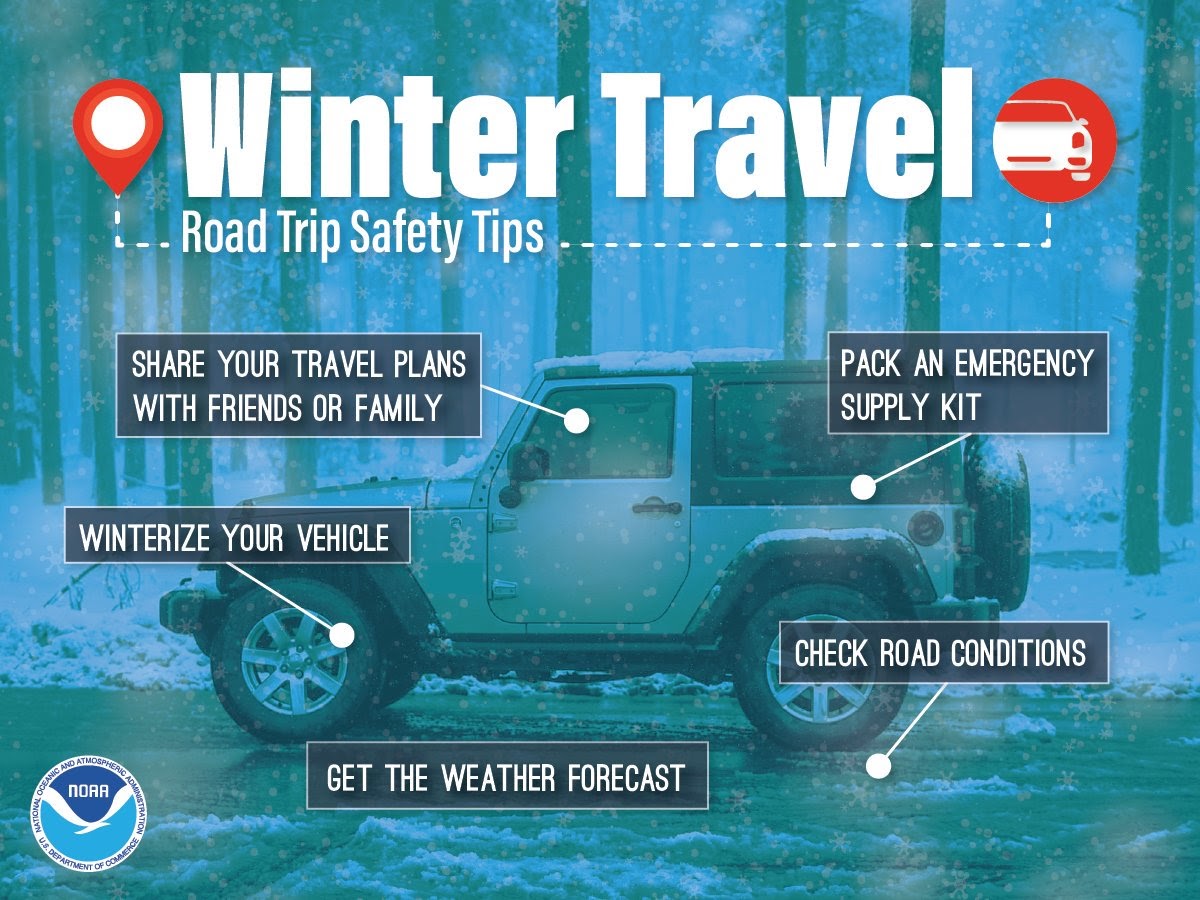
Winter storms can strike quickly, delivering a myriad of dangerous conditions and life-threatening hazards to those outdoors. It’s important to always consult the latest weather forecasts, advisories, and warnings at weather.gov before finalizing your outdoor plans.
If you are traveling by car, ensure your Winter Safety Kit is kept updated.
So what should you do if you’re unexpectedly caught outdoors in a winter storm? Follow these important tips.
- Find Shelter: Try to stay dry and cover all exposed body parts.
- When There Is No Shelter Nearby: Build a lean-to, windbreak, or snow cave for protection from the wind. Build a fire for heat and to attract attention. Place rocks around the fire to absorb and reflect heat.
- Melt Snow for Drinking Water: Eating un-melted snow will lower your body temperature.
- Exercise: From time to time, move arms, legs, fingers, and toes vigorously to keep blood circulating and to keep warm. Avoid overexertion from shoveling heavy snow, pushing a car, or walking in deep snow, especially if you are not in good health. Sweating can lead to chill and hypothermia, and the strain from the cold and hard labor may cause a heart attack.
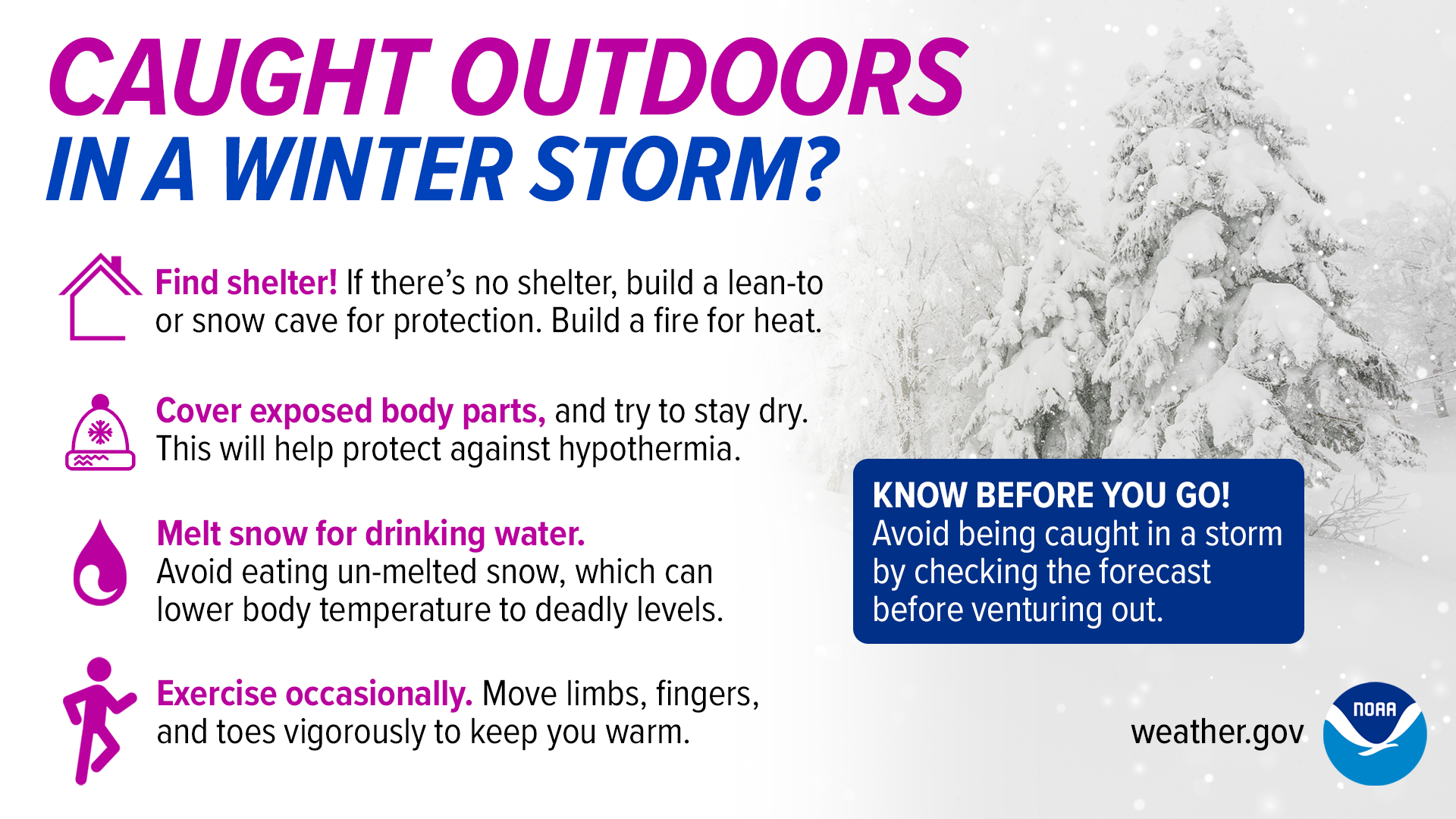
Staying in your car when stranded is often the safest choice when winter storms create poor visibility or cover roadways in ice. These steps will increase your safety when stranded:
- Tie a brightly colored cloth to the antenna and (if it is not snowing) raise the hood of the car to signal first responders.
- Move anything you need from the trunk into the passenger area.
- Wrap your entire body, including your head, in extra clothing, blankets, or newspapers.
- Stay awake. You will be less vulnerable to cold-related health problems.
- Run the motor (and heater) for about 10 minutes per hour, opening one window slightly to let in air. Make sure that snow is not blocking the exhaust pipe – this will reduce the risk of carbon monoxide poisoning.
- As you sit, keep moving your arms and legs to improve your circulation and stay warmer.
- Stay hydrated by drinking water from your winter safety kit or by melting snow. Do not eat the snow because it will lower your body temperature.
- Huddle with other people for warmth.
- After the storm, be aware of snow and ice loads, and use extreme caution around larger branches and trees which can give way, causing serious injury or death.
References:
When is ice safe to venture out on? There really is no sure answer. Ice appearance is far from sufficient to determine ice safety since its strength is determined by many factors including age, thickness, temperature, and whether it has snow on top. Additional factors include the depth of water underneath, water body size, water currents, local climate conditions, and even water chemistry. The bottom line is that your safety on ice is your responsibility, and you should be sure to check ice thickness at least every 150 feet.

Avalanches kill more than 150 people worldwide each year. While avalanches are sudden, there are typically a number of warning signs before one occurs, such as cracks in the snow, strong winds, heavy snowfall, or rapid warming. Unfortunately, in 90 percent of avalanche incidents, the snow slides are triggered by the victim or someone in the victim's party.
While in the backcountry, be conservative in your decisions. Do not let the fact that you are carrying extra gear lead to overconfidence and risk taking. Avalanches happen suddenly, move quickly, and travel long distances. Always take the safer option.
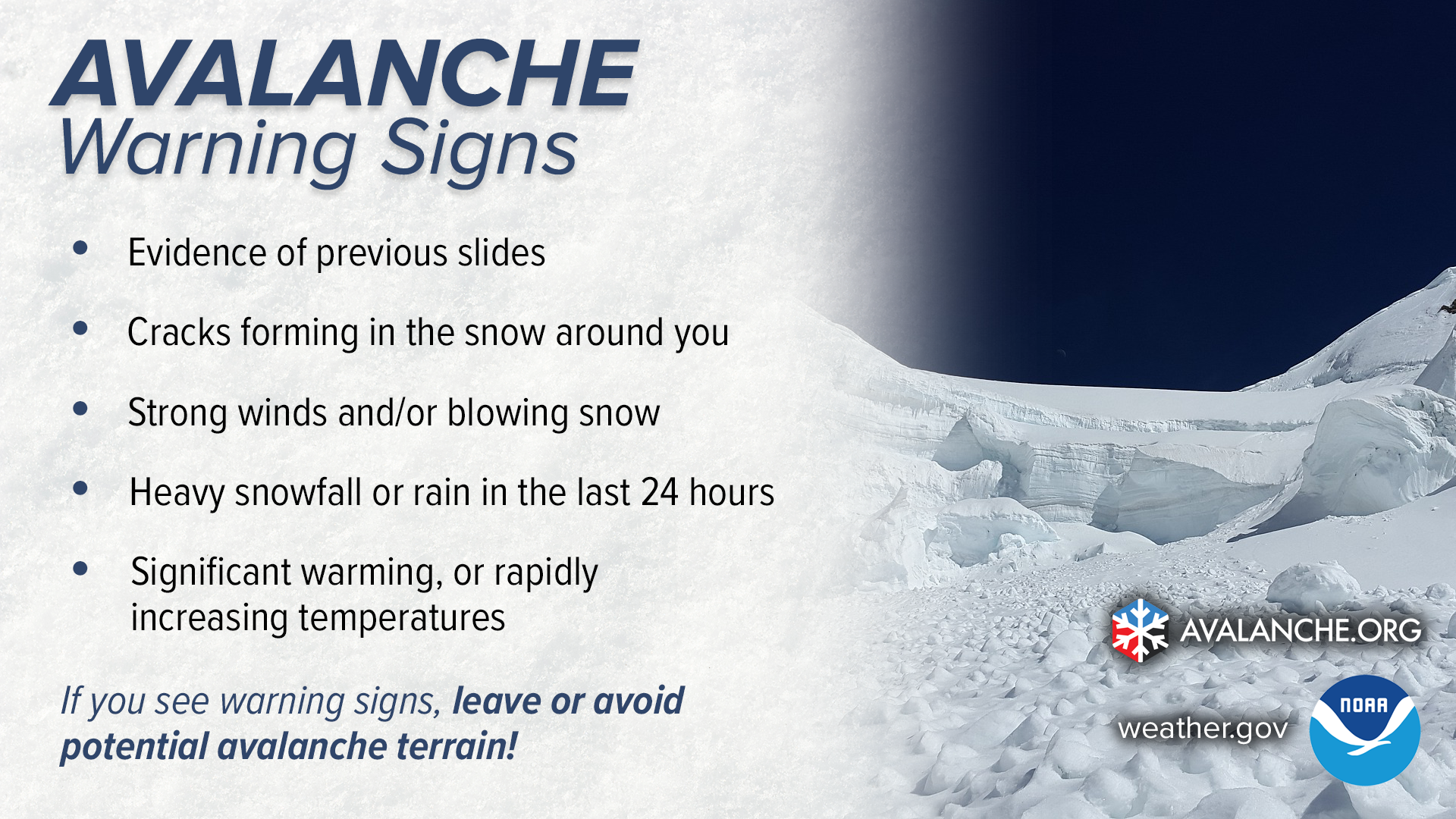
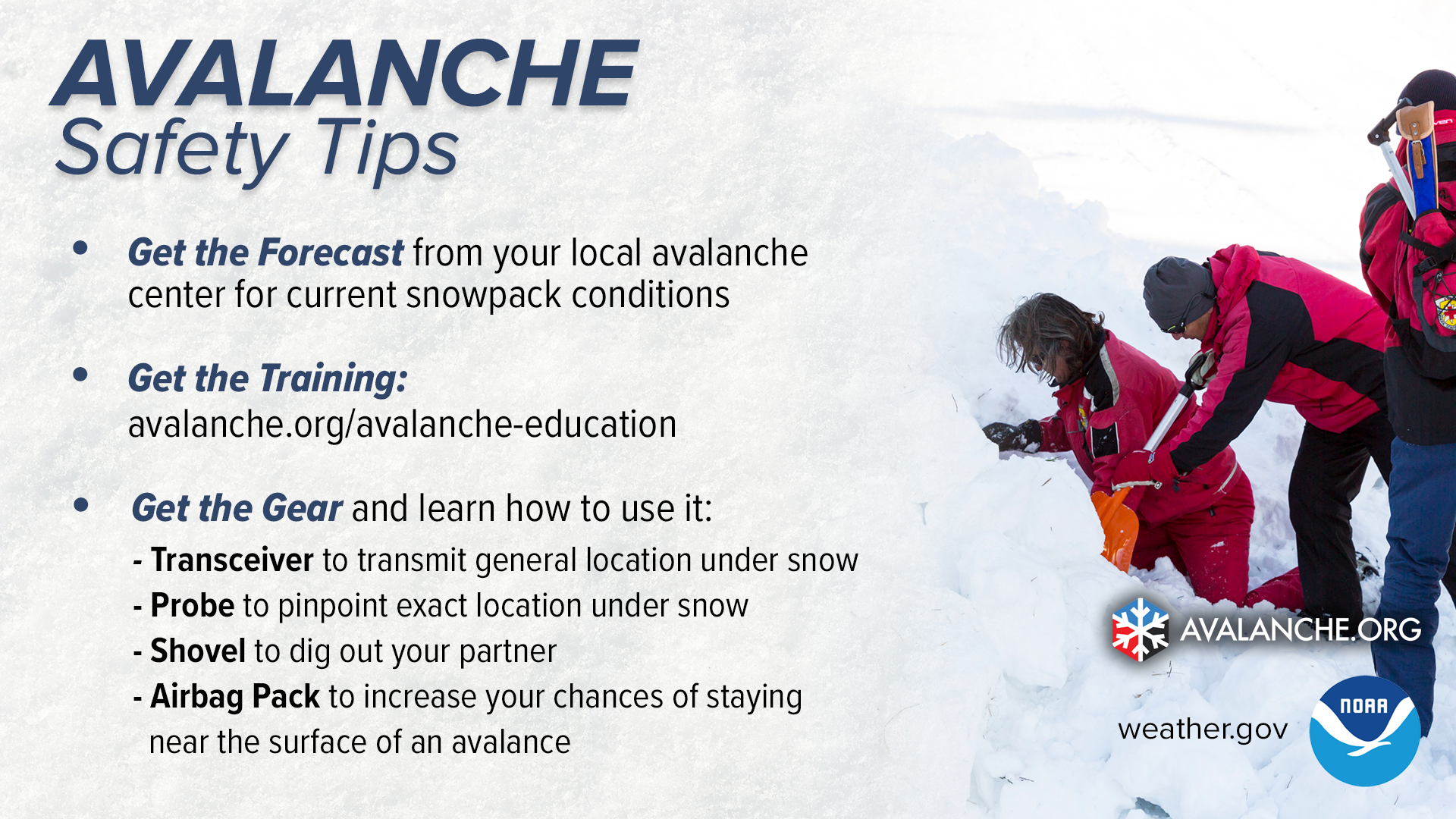
The National Weather Service provides current weather conditions and forecast information to the regional avalanche centers that issue avalanche forecasts and alerts. Hikers and backcountry skiers should check the latest snowpack conditions before heading out and during outdoor activities. Be prepared to receive and heed avalanche warnings and special bulletins broadcast over NOAA Weather Radio, NWS websites, and avalanche center websites. Refer to your local avalanche center via avalanche.org offsite link for current snowpack conditions.
Learn more about avalanche safety at avalanche.org offsite link.
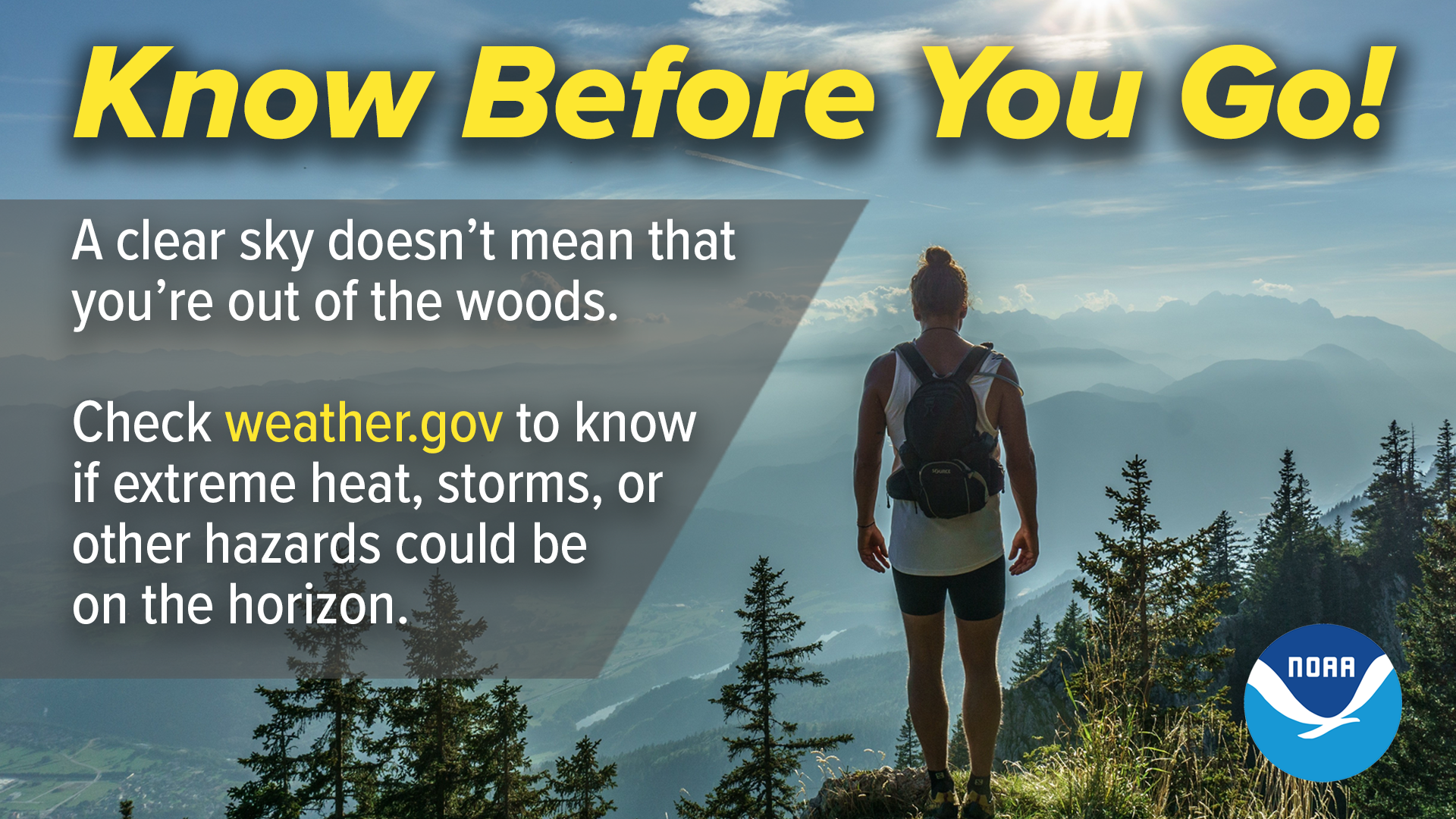
Additional Resources:
- NOAA's National Weather Service
Check the forecast and learn more about weather safety. - National Park Service Health and Safety
Find parks and explore nature. - FEMA’s Ready.gov
Plan ahead for disasters.
The Great Outdoors are wondrous, awe inspiring, and both physically and mentally beneficial to experience. However, the Great Outdoors bring with them various weather and environmental hazards that can ruin your adventure and even be very dangerous. It is important to know your risks, take action to prepare and minimize those risks, and serve as an example for others to emulate. Here are some fundamental actions you can take and safety content you can share with family, friends, and across social media.


The Great Outdoors, especially during the warmer months, can be susceptible to quick forming thunderstorms. The weather can change dramatically in mountainous areas and near large bodies of water. Extreme weather can be a bit more extreme in the Great Outdoors. Make sure you plan ahead and “know before you go” to the chances of lightning in the forecast.
Some quick tips include:
- Schedule day hikes or other activities to avoid times when thunderstorms are possible (which typically form in the late afternoon).
- Identify locations with adequate shelter and reduced exposure to lightning.
- Keep a close watch of the sky and look for those towering clouds bubbling upward. These can be thunderstorms forming.
Are you planning to camp or hike near a stream or river? Remember that it doesn’t have to rain directly over you for there to be flooding. If you notice even a slight rise in water level, seek higher ground immediately!
Slot canyon flash flooding
Slot canyons are nature’s masterpieces, but are also susceptible to flash flooding. Flooding can occur even if there is blue sky above as rainwater can flow from an area that flows into the slot canyon.
Know the signs of an impending flash flood:
- Rising water levels and/or stronger currents
- Increasing roar of water up canyon
- Floating debris
- Sudden changes in water from clear to muddy
Videos:

During hot and humid weather, your body's ability to cool itself is challenged in ways you may not expect. When your body heats too rapidly, or when too much fluid or salt is lost through dehydration or sweating, you could experience a heat-related illness.
Stay safe outdoors during the heat:
- Slow down. Reduce, eliminate or reschedule strenuous activities until the coolest time of the day.
- Drink plenty of water (not very cold), non-alcoholic and decaffeinated fluids, even if you don't feel thirsty.
- Dress for summer. Wear lightweight, loose fitting, light-colored clothing to reflect heat and sunlight.
- Minimize direct exposure to the sun. Sunburn reduces your body's ability to dissipate heat.
- Eat light, cool, easy-to-digest foods such as fruit or salads. If you pack food, put it in a cooler or carry an ice pack. Don't leave it sitting in the sun. Meats and dairy products can spoil quickly in hot weather.

Everyone is at risk to the dangers of heat illness, but some people are especially vulnerable:
- Newborns / children
- Pregnant people
- The elderly
- People with chronic illness
Age and certain conditions make the body less able to regulate temperature. Take extra care to ensure they remain safe from the heat.

Before you go out, check the check the air quality forecast.
Poor air quality can be hazardous to anyone, and it can aggravate health problems such as asthma, heart disease, and lung disease. Seniors, children and those with compromised immune systems are especially at risk.
Air quality is reported using the Air Quality Index (AQI). It tells you how clean or polluted your air is, and what associated health effects might be a concern for you. The higher the number, the greater the health concern. Learn more about the AQI at airnow.gov/aqi/aqi-basics

When planning a winter outing, stay safe! Check the forecast ahead of time, pack necessary gear, and dress appropriately for expected conditions. Winter conditions can change rapidly, and failure to adequately plan can be life-threatening. Weather.gov should be visited early and often.
Outdoor winter adventures expose individuals to multiple safety hazards, and extreme cold tops the list. Extreme cold magnifies the risk of cold-related illnesses, including frostbite and hypothermia, a serious condition involving a drop in body temperature and requiring immediate medical attention (It’s important to understand, however, that prolonged exposure to any environment colder than your body temperature can lead to hypothermia. This includes immersion into cold water even when the air temperature is warm).


Dressing in layers prevents your body from becoming too warm or cold by creating layers of insulating air. A moisture-wicking material as your first layer will prevent clothing from trapping moisture/sweat against your skin, and a waterproof but breathable outer layer is highly recommended. Waterproof boots are a great choice for footwear since wet feet lose heat 25 times faster than dry feet. Gloves, ear muffs, and head coverings should also be worn, as frostbite can begin on exposed skin just minutes after exposure to bitterly cold wind chills.
Do Not Venture Out Alone
Winter landscapes can be decorated in layers of snow and ice, but the snowy surroundings can quickly become disorienting, causing you to lose your sense of direction. Hiking with a companion decreases the risk of getting lost, and if an accident happens, having a safety partner improves your chances of returning safely.
If you head out alone, always inform someone of where you are going and what time you will return. Stock essential items in your car and backpack in case of an emergency.
References:

Winter storms can strike quickly, delivering a myriad of dangerous conditions and life-threatening hazards to those outdoors. It’s important to always consult the latest weather forecasts, advisories, and warnings at weather.gov before finalizing your outdoor plans.
If you are traveling by car, ensure your Winter Safety Kit is kept updated.
So what should you do if you’re unexpectedly caught outdoors in a winter storm? Follow these important tips.
- Find Shelter: Try to stay dry and cover all exposed body parts.
- When There Is No Shelter Nearby: Build a lean-to, windbreak, or snow cave for protection from the wind. Build a fire for heat and to attract attention. Place rocks around the fire to absorb and reflect heat.
- Melt Snow for Drinking Water: Eating un-melted snow will lower your body temperature.
- Exercise: From time to time, move arms, legs, fingers, and toes vigorously to keep blood circulating and to keep warm. Avoid overexertion from shoveling heavy snow, pushing a car, or walking in deep snow, especially if you are not in good health. Sweating can lead to chill and hypothermia, and the strain from the cold and hard labor may cause a heart attack.

Staying in your car when stranded is often the safest choice when winter storms create poor visibility or cover roadways in ice. These steps will increase your safety when stranded:
- Tie a brightly colored cloth to the antenna and (if it is not snowing) raise the hood of the car to signal first responders.
- Move anything you need from the trunk into the passenger area.
- Wrap your entire body, including your head, in extra clothing, blankets, or newspapers.
- Stay awake. You will be less vulnerable to cold-related health problems.
- Run the motor (and heater) for about 10 minutes per hour, opening one window slightly to let in air. Make sure that snow is not blocking the exhaust pipe – this will reduce the risk of carbon monoxide poisoning.
- As you sit, keep moving your arms and legs to improve your circulation and stay warmer.
- Stay hydrated by drinking water from your winter safety kit or by melting snow. Do not eat the snow because it will lower your body temperature.
- Huddle with other people for warmth.
- After the storm, be aware of snow and ice loads, and use extreme caution around larger branches and trees which can give way, causing serious injury or death.
References:
When is ice safe to venture out on? There really is no sure answer. Ice appearance is far from sufficient to determine ice safety since its strength is determined by many factors including age, thickness, temperature, and whether it has snow on top. Additional factors include the depth of water underneath, water body size, water currents, local climate conditions, and even water chemistry. The bottom line is that your safety on ice is your responsibility, and you should be sure to check ice thickness at least every 150 feet.

Avalanches kill more than 150 people worldwide each year. While avalanches are sudden, there are typically a number of warning signs before one occurs, such as cracks in the snow, strong winds, heavy snowfall, or rapid warming. Unfortunately, in 90 percent of avalanche incidents, the snow slides are triggered by the victim or someone in the victim's party.
While in the backcountry, be conservative in your decisions. Do not let the fact that you are carrying extra gear lead to overconfidence and risk taking. Avalanches happen suddenly, move quickly, and travel long distances. Always take the safer option.


The National Weather Service provides current weather conditions and forecast information to the regional avalanche centers that issue avalanche forecasts and alerts. Hikers and backcountry skiers should check the latest snowpack conditions before heading out and during outdoor activities. Be prepared to receive and heed avalanche warnings and special bulletins broadcast over NOAA Weather Radio, NWS websites, and avalanche center websites. Refer to your local avalanche center via avalanche.org offsite link for current snowpack conditions.
Learn more about avalanche safety at avalanche.org offsite link.

Additional Resources:
- NOAA's National Weather Service
Check the forecast and learn more about weather safety. - National Park Service Health and Safety
Find parks and explore nature. - FEMA’s Ready.gov
Plan ahead for disasters.


